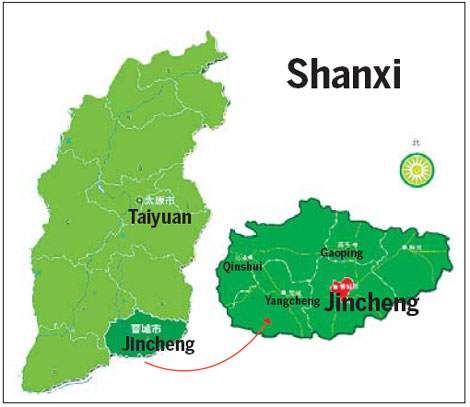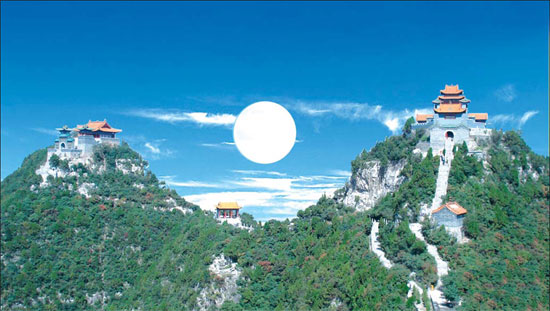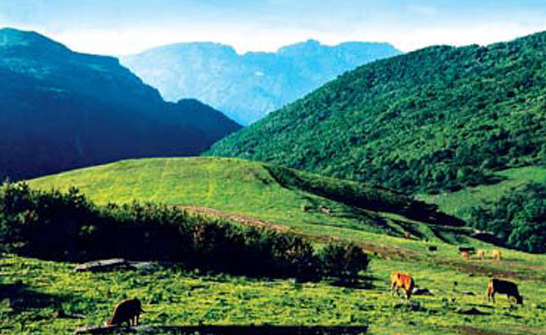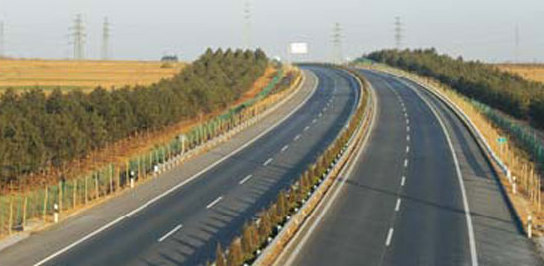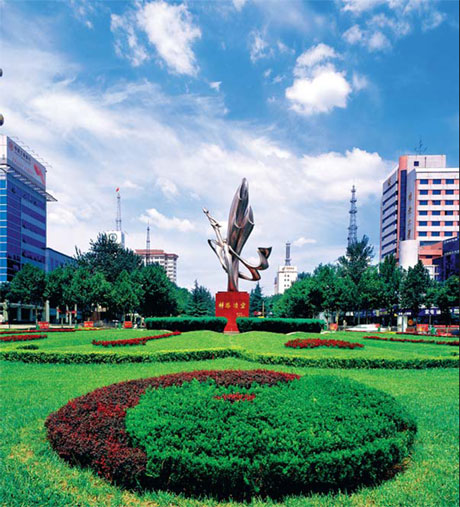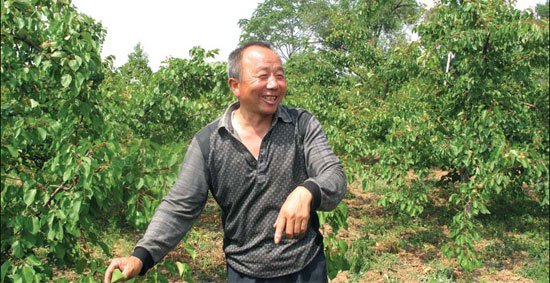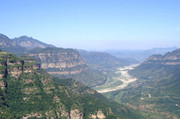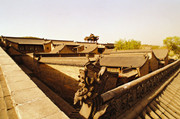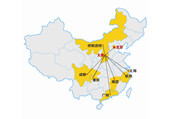Jincheng: The coal city that's turning green
By Sun Ruisheng in Jincheng, Shanxi and He Dan in Beijing ( China Daily )
Updated: 2012-11-09
|
With blue sky and ancient architecture, Yushan Mountain is a well-known sight in the city. Photos provided to China Daily |
|
Lishan Mountain in southern Shanxi is a national nature reserve surrounded by forests. |
|
Newly planted pine trees line the city's ring road. |
|
"Green" is the logo of Jincheng's brand image. |
|
Shen Yuxi, a farmer in Jincheng, tells how he turned desert into green land. |
Among the best natural habitats in Shanxi province
The city of Jincheng in Shanxi province's southeast looks peaceful and beautiful after a downpour in the morning.
Local residents walk in and out of a park for morning exercises. Seniors practice tai chi, women perform fan dances and young people move in steps to music.
Yuan Xiulan, a woman in her 40s, said she has seen the city become greener and cleaner, adding that she feels pride to know her home city was named one of the "Top 10 leisure cities in China" in 2011.
Dubbed the pearl of Taihang Mountain, Jincheng faces the mountain to its east and the Yellow River to its west. The geographic location makes it a convenient place for transportation as Shanxi is a doorway to China's central provinces.
Six counties and cities - Zezhou, Gaoping, Yangcheng, Linchuan and Qinshui - are under the administration of Jincheng.
Covering 9,490 square kilometers, it accounts for 6 percent of the land in Shanxi province. Its total arable land is about 189,000 hectares.
A green city
Jincheng, known for coal mining, surprises visitors with its green color.
Official numbers tell the story of the coal city's determination to go green and follow an environmentally friendly development model.
The city government has invested more than 200 million yuan ($32 million) to improve the environment in recent years.
By planting trees and grasses on barren mountains, excavated surfaces of coal mines and other lands, the local government increased green coverage to 1,467 hectares, some 15.5 square meters per capita.
The 60 sq km Baimasi Eco-zone in the north of the city has been developed as the "green heart" of Jincheng. This zone has been designed for leisure, an arboretum, agricultural sightseeing, religion and folk culture.
The city government is also growing greenbelts along ring expressways, expanding forest coverage in mountains and protecting natural parks.
It now has 29 city parks and seven forest parks in suburban areas with a total land of 20,000 hectares.
The government has renovated Zezhou Park, Zhaoshuli Park and Qixing Park Square by expanding the green land and updating facilities.
It has completed greenery projects with trees and flowers near the city's three highway tollbooths.
"Recent years saw the forest developing the fastest and healthiest," said Wang Antai, deputy director of the Jincheng forestry bureau.
Wang said his department alone spent more than 2 billion yuan during the 11th Five-Year Plan period (2006-10), 10 times the previous period, which helped to plant more than 44,700 hectares trees.
To date, greenbelts have been built along 4,475 km of freeways and in more than 460 villages. The villages of Dongsiyi, Nanshan, Xingwangzhuang and Shan'erdong have been titled "national green and affluent villages", Wang said.
About 39 percent of the city is covered with forest, some 20 percentage points higher than the provincial average, he said.
The local government has also introduced an environmental policy that requires mining to shoulder more social responsibilities.
Mine owners have to pay tax for each ton of coal they mine, with the revenue used to subsidize farmers who plant trees. Coal producers have also been encouraged to plant trees in mining areas and get involved in turning barren mountains into forest.
The policy has turned Qifu Mountain from bare desolation into a popular resort for locals and hikers.
Qinshui county has preserved 730 hectares of natural forest in Shanxi. Jincheng has 254,700 hectares of grassland, accounting for 26.8 percent of total area of the city.
As a result, the city has become a major natural habitat for wild animals in Shanxi. The largest pasture in North China is located in Qinshui county, Jincheng city.
The wildlife and flora earned the city a title as the "treasury house of biological resources in Shanxi". Nature reserves at the Manghe River of Yangcheng and Lishan Mountain of Qinshui include rare animals such as the macaque and giant salamander.
A clean city
A coal city in China usually conjures up images of dust and smoggy air.
Although Jincheng still has a rich reserves of coal, the city government has made great efforts to make it more habitable by initiating a comprehensive approach that targets reducing air pollution, easing traffic congestion and improving sanitation.
The city government introduced a "blue-sky days" program that shut down or relocated 15 factories with heavy pollution and promoted clean energy.
Since 2008, the city government has been working to promote use of coal-bed methane, a high-energy unconventional gas that burns cleaner than coal.
At present, 156,700 urban and rural households and more than 600 companies, along with 9,000 buses and private cars, are fueled by clean energy.
As well, more than half of new buildings in the city since 2008 are energy-saving.
The winter heating systems in five major districts have been reconstructed to use gas instead of coal.
Traffic authorities have established several monitoring centers across the city to test emissions from automobile exhaust and imposed stringent measures to control fumes discharged by cars.
To relieve traffic pressure from rising numbers of cars and rapid urbanization, the government invested 2.3 billion yuan to build 16 new roads and repaired old roads.
The government has allocated 15 million yuan annually for sanitation work. More than 1,100 sanitation workers ensure 24-hour service on the streets and recycling waste across the city.
Quality labor
The city's policymakers believe that its residents' quality of life is key to its development.
As a young and dynamic city, Jincheng has considerable numbers of migrant workers seeking their fortune, an influx of businessmen and investors coming for business opportunities and tourists for sightseeing.
As a result, the city government faces challenges form the high mobility of labor, and shortfalls in capital and logistics.
The government has worked hard to improve the work capacity and efficiency of its public employees by offering numerous training programs.
The local government also focuses on improving ethics among residents by encouraging people to learn from role models, who are often elected by the public's vote via phone calls, Internet or other ways.
Such role-model election activities have attracted the public's active participation. People have growing awareness of environmental protection and proper behavior in public places.
Rapid development
Improvements in the urban environment are attracting investment from world-renowned companies and leading domestic enterprises such as Taiwan's Foxconn, Henderson, Haud, State Development & Investment Corp, Sinopec, PetroChina and Luneng.
More than 40 cooperation contracts have been signed with those companies and new factories have been set up in Jincheng.
Investors show growing enthusiasm in Jincheng as the number of contracts and capital expenditures rise at a variety of large business fairs such as Central China Expo, China International Equipment & Manufacturing Expo and China International Energy Industry Expo.
Jincheng has hosted an increasing number of cultural and sports events such as the Chinese Olympic swimming team selection tournament, a Sino-foreign basketball game, international boxing game, the International Photography Golden Lens presentation ceremony.
Jincheng has a long history of silk production and it is an important production center for silkworm cocoons and silk in North China.
Its silk production accounts for 80 percent of Shanxi province, making Jincheng the largest production base in North China.
There is also huge potential for Jincheng to develop its tourism industry.
The Xiachuan archeological site and Lishan Natural Reserve in Qinshui county have deep valleys, verdant forests, waterfalls and touching legends that make it charming to outsiders.
The Manghe River Natural Reserve is one of the famous places of interests in Shanxi, known for its rich flora and macaques living in the forest.
In Lingchuan county tourists can visit Qizi Mountain, where the ancient Chinese chess game weiqi was born.
Contact the writers at sunruisheng@chinadaily.com.cn and hedan@chinadaily.com.cn
